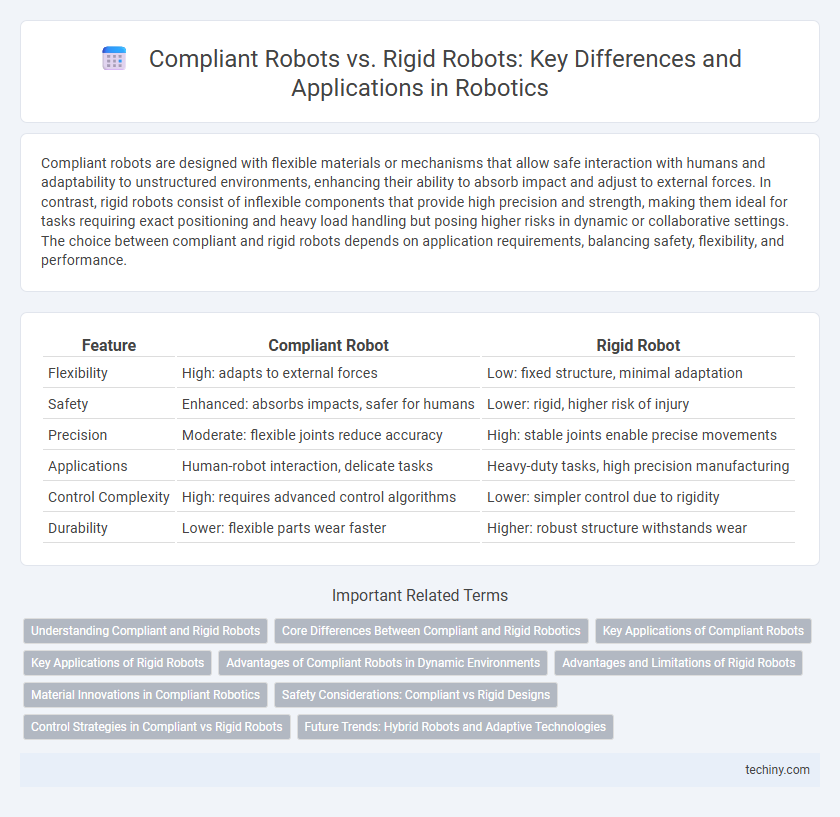Compliant robots are designed with flexible materials or mechanisms that allow safe interaction with humans and adaptability to unstructured environments, enhancing their ability to absorb impact and adjust to external forces. In contrast, rigid robots consist of inflexible components that provide high precision and strength, making them ideal for tasks requiring exact positioning and heavy load handling but posing higher risks in dynamic or collaborative settings. The choice between compliant and rigid robots depends on application requirements, balancing safety, flexibility, and performance.
Table of Comparison
| Feature | Compliant Robot | Rigid Robot |
|---|---|---|
| Flexibility | High: adapts to external forces | Low: fixed structure, minimal adaptation |
| Safety | Enhanced: absorbs impacts, safer for humans | Lower: rigid, higher risk of injury |
| Precision | Moderate: flexible joints reduce accuracy | High: stable joints enable precise movements |
| Applications | Human-robot interaction, delicate tasks | Heavy-duty tasks, high precision manufacturing |
| Control Complexity | High: requires advanced control algorithms | Lower: simpler control due to rigidity |
| Durability | Lower: flexible parts wear faster | Higher: robust structure withstands wear |
Understanding Compliant and Rigid Robots
Compliant robots feature flexible structures and materials that absorb impacts and adapt to uncertain environments, enhancing safety and collaboration with humans. Rigid robots are constructed with stiff components to provide precise, high-speed, and repeatable movements, ideal for tasks requiring accuracy and strength. Understanding these differences is essential for selecting appropriate robotic systems in manufacturing, healthcare, and service applications.
Core Differences Between Compliant and Rigid Robotics
Compliant robots integrate flexible materials and sensors, allowing adaptive responses to external forces and safe human-robot interaction, while rigid robots rely on stiff structures and precise control for high accuracy and repeatability. The core difference lies in their mechanical design, where compliant robots excel in dynamic, unstructured environments, and rigid robots specialize in tasks requiring consistent precision and strength. This distinction influences their applications, with compliant robots favored in collaborative settings and rigid robots dominating industrial automation.
Key Applications of Compliant Robots
Compliant robots excel in tasks requiring delicate interaction, such as medical surgery, prosthetics, and collaborative assembly lines, where adaptability and safety are crucial. Their ability to absorb shocks and adjust to environmental variations makes them ideal for human-robot collaboration and handling fragile objects. Industries like healthcare, manufacturing, and service robotics increasingly adopt compliant robots to enhance precision and reduce injury risks.
Key Applications of Rigid Robots
Rigid robots excel in high-precision, high-speed assembly lines within automotive manufacturing, where consistent repeatability and strength are critical. They are extensively used in welding, painting, and material handling due to their robust structure and ability to operate in harsh environments. Their rigidity allows for precise machining and heavy payload management, making them indispensable in metal fabrication and electronics production.
Advantages of Compliant Robots in Dynamic Environments
Compliant robots excel in dynamic environments due to their inherent flexibility, which allows safe interactions with unpredictable objects and humans by absorbing shocks and adapting to external forces. Their ability to perform delicate tasks with precision minimizes damage to both the robot and its surroundings, enhancing operational safety and efficiency. This adaptability reduces the need for complex control systems and extensive programming, enabling faster deployment in changing or unstructured settings.
Advantages and Limitations of Rigid Robots
Rigid robots offer high precision, repeatability, and load-bearing capacity, making them ideal for tasks requiring consistent accuracy and strength in manufacturing and assembly lines. Their limitations include reduced adaptability to unstructured environments and potential safety risks when interacting with humans due to their inflexible structure. Despite these constraints, rigid robots excel in high-speed operations where stability and durability are critical.
Material Innovations in Compliant Robotics
Material innovations in compliant robotics emphasize the use of soft polymers, elastomers, and shape-memory alloys to achieve flexibility and adaptability in robotic mechanisms. These advanced materials enable compliant robots to safely interact with unpredictable environments and human users by providing intrinsic compliance without relying solely on complex control systems. Integration of bio-inspired materials and smart substrates enhances the performance and durability of compliant robots in dynamic and unstructured settings.
Safety Considerations: Compliant vs Rigid Designs
Compliant robots enhance safety by incorporating flexible materials and adaptive control systems that absorb impact forces and reduce injury risks during human-robot interaction. Rigid robots, while offering precision and strength, pose higher hazards due to their inflexible structures, increasing the likelihood of severe accidents in unexpected collisions. Prioritizing compliant robot designs in collaborative environments significantly improves workplace safety and minimizes downtime caused by accidents.
Control Strategies in Compliant vs Rigid Robots
Control strategies in compliant robots emphasize adaptive and flexible feedback mechanisms to manage variable stiffness and enhance safe human-robot interaction. In contrast, rigid robots rely on precise, model-based control algorithms that prioritize stability and accuracy under fixed, high-stiffness conditions. Advanced compliant control techniques integrate sensor fusion and impedance control to modulate force and position dynamically, while rigid robot controls typically use PID or model predictive control to maintain rigid positional accuracy.
Future Trends: Hybrid Robots and Adaptive Technologies
Future trends in robotics emphasize the development of hybrid robots combining compliant and rigid elements to optimize flexibility and strength for diverse applications. Adaptive technologies, including advanced sensors and AI-driven control systems, enhance these robots' ability to dynamically adjust stiffness and interaction forces in real-time. This integration drives innovations in collaborative robots (cobots) and soft robotics, expanding functionality in manufacturing, healthcare, and service industries.
compliant robot vs rigid robot Infographic

 techiny.com
techiny.com